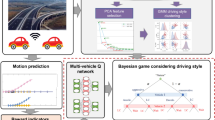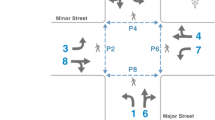Abstract
Merging areas on freeways are key locations due to vehicles’ fixed lateral differences. Though, such challenges are considerably unnecessary with connected and autonomous vehicle (CAV) technology. In recent times, the existing studies focusing on CAV methodology intend to merge the maneuvers among an incoming ramp and a single-lane mainline. This paper develops the lane optimization model for CAV system for solving the complexities of multilane merging areas. The two major stages of the proposed model are lane changing and lane merging control optimization. For performing the lane changing control optimization, a self adaptive-electric fish optimization (SA-EFO)-based “cooperative lane changing control (CLCC)” is developed. The significant aim of the SA-EFO-based CLCC is to exploit the average velocity concerning the entire vehicles. Once the lane changing control strategies is done, lane merging control is performed through “cooperative merging control” optimization using the same proposed SA-EFO with the intention of maximizing the vehicle's average velocity. Finally, the simulation of the designed model reveals that the developed model is superior to existing merging algorithms over the existing models under different demand scenarios.









Similar content being viewed by others
References
Xiangwang, Hu., & Sun, J. (2019). Trajectory optimization of connected and autonomous vehicles at a multilane freeway merging area. Transportation Research Part C: Emerging Technologies, 101, 111–125.
Treiber, M., & Kesting, A. (2014). Traffic flow dynamics data, models and simulation. Physics Today, 67(3), 54.
Li, Z., Chung, K., & Cassidy, M. J. (2013). Collisions in freeway traffic: The influence of downstream queues and interim means to address it. Transportation Research Record, 2396, 1–9.
Ahn, S., Coifman, B., Gayah, V., Hadi, M., Hamdar, S., Leclercq, L., Mahmassani, H., Menendez, M., Skabardonis, A., & van Lint, H. (2019). Traffic flow theory and characteristics. Transportation Research Board.
Zheng, Z. (2021). Reasons, challenges, and some tools for doing reproducible transportation research. Communications in Transportation Research, 1, 100004.
Min, H., Yang, Y., Fang, Y., Sun, P., & Zhao, X. (2019). Constrained optimization and distributed model predictive control-based merging strategies for adjacent connected autonomous vehicle platoons. IEEE Access, 7, 163085–163096.
Davis, L. C. (2020). Optimal merging into a high-speed lane dedicated to connected autonomous vehicles. Physica A: Statistical Mechanics and its Applications, 555, 124743.
Tashiro, M., Motoyama, H., Ichioka, Y., Miwa, T., & Morikawa, T. (2018). Simulation analysis on optimal merging control of connected vehicles for minimizing travel time. International Journal of Intelligent Transportation Systems Research, 18, 65–76.
Davis, L. C. (2018). Optimal merging from an on-ramp into a high-speed lane dedicated to connected autonomous vehicles. 10244 Normandy Dr., Plymouth, MI 48170, United States.
Hussain, S. A., Shahian-Jahromi, B., Karakas, B., & Cetin, S. (2018). Highway lane merge for autonomous vehicles without an acceleration area using optimal model predictive control. World Journal of Research and Review (WJRR), 6(3), 27–32.
Gao, Z., Wu, Z., Hao, W., Long, K. (2020). Deployment optimization of connected and automated vehicle lanes with the safety benefits on roadway networks. Journal of Advanced Transportation, 2020.
Letter, C., & Elefteriadou, L. (2017). Efficient control of fully automated connected vehicles at freeway merge segments. Transportation Research Part C: Emerging Technologies, 80, 190–205.
Liu, J., & Khattak, A. J. (2016). Delivering improved alerts, warnings, and control assistance using basic safety messages transmitted between connected vehicles. Transportation Research Part C: Emerging Technologies, 68, 83–100.
Mahmassani, H. S. (2016). Autonomous vehicles and connected vehicle systems: Flow and operations considerations. Transportation Science, 50, 1140–1162.
Ni, D., Li, J., Andrews, S., & Wang, H. (2012). A methodology to estimate capacity impact due to connected vehicle technology. International Journal of Vehicular Technology., 2012, 1–10.
Xie, Y., Zhang, H., Gartner, N. H., & Arsava, T. (2016). Collaborative merging strategy for freeway ramp operations in a connected and autonomous vehicles environment. Journal of Intelligent Transportation Systems, 21, 136–147.
Wu, J., Wang, Y., Wang, L., Shen, Z., & Yin, C. (2018). Consensus-based platoon forming for connected autonomous vehicles. IFAC-Papers OnLine, 51(31), 801–806.
Ye, L., & Yamamoto, T. (2018). Impact of dedicated lanes for connected and autonomous vehicle on traffic flow throughput. Physica A: Statistical Mechanics and its Applications, 512, 588–597.
Khattak, Z. H., Smith, B. L., Park, H., & Fontaine, M. D. (2020). Cooperative lane control application for fully connected and automated vehicles at multilane freeways. Transportation Research Part C: Emerging Technologies, 111, 294–317.
Orosz, G. (2016). Connected cruise control: Modelling, delay effects, and nonlinear behavior. International Journal of Vehicle Mechanics and Mobility., 54(8), 1147–1176.
Lee, J., & Park, B. (2012). Development and evaluation of a cooperative vehicle intersection control algorithm under the connected vehicles environment. IEEE Transaction on Intelligent Transportation Systems, 13(1), 81–90.
Zheng, Y., Jin, L., Jiang, Y., Wang, F., Guan, X., Ji, S., & Xu, J. (2017). Research on cooperative vehicle intersection control scheme without using traffic lights under the connected vehicles environment. Journal of Advances in Mechanical Engineering, 9(8), 1–13.
Rajamani, R., & Shladover, S. (2001). An experimental comparative study of autonomous and co-operative vehicle-follower control systems. Transportation Research Part C: Emerging Technologies., 9(1), 15–31.
Soh, A. C., Khalid, M., Marhaban, M. H., & Yusof, R. (2009). Modeling of a multilane-multiple intersection based on queue theory and standard approach techniques. Simulation Modelling Practice and Theory, 17(6), 1081–1105.
Ali, Y., Zheng, Z., Haque, M. M., Yildirimoglu, M., & Washington, S. (2020). Detecting, analysing, and modelling failed lane-changing attempts in traditional and connected environments. Analytic Methods in Accident Research, 28, 100138.
Jiang, H., Hu, J., An, S., Wang, M., & Park, B. B. (2017). Eco approaching at an isolated signalized intersection under partially connected and automated vehicles environment. Transportation Research Part C: Emerging Technologies, 79, 290–307.
Wang, Z., Wu, G. Y., & Barth, M. J. (2019). Cooperative eco-driving at signalized intersections in a partially connected and automated vehicle environment. IEEE Transactions on Intelligent Transportation Systems, 21, 1–10.
Talebpou, A., & Mahmassani, H. S. (2016). Influence of connected and autonomous vehicles on traffic flow stability and throughput. Transportation Research Part C: Emerging Technologies, 71, 143–163.
Li, L., & Li, X. (2019). Parsimonious trajectory design of connected automated traffic. Transportation Research Part B: Methodological, 119, 1–21.
Ghiasi, A., Hussain, O., Qian, Z., & Li, X. (2017). A mixed traffic capacity analysis and lane management model for connected automated vehicles: A Markov chain method. Transportation Research Part B: Methodological, 106, 266–292.
Ali, Y., Bliemer, M. C. J., Zheng, Z., & Haque, M. M. (2020). Comparing the usefulness of real-time driving aids in a connected environment during mandatory and discretionary lane-changing manoeuvres. Transportation Research Part C: Emerging Technologies, 121, 102871.
Ali, Y., Zheng, Z., Haque, M. M., Yildirimoglu, M., & Washington, S. (2021). CLACD: A complete lane-changing decision modeling framework for the connected and traditional environments. Transportation Research Part C: Emerging Technologies, 128, 103162.
Zheng, Z. (2014). Recent developments and research needs in modeling lane changing. Transportation Research Part B: Methodological, 60, 16–32.
Tabjula, J., Kalyani, S., Rajagopal, P., & Srinivasan, B. (2021). Statistics-based baseline-free approach for rapid inspection of delamination in composite structures using ultrasonic guided waves. Structural Health Monitoring (2021).
Rajakumar, B. R. (2013). Impact of static and adaptive mutation techniques on genetic algorithm. International Journal of Hybrid Intelligent Systems, 10(1), 11–22.
Rajakumar, B. R. (2013). Static and adaptive mutation techniques for genetic algorithm: A systematic comparative analysis. International Journal of Computational Science and Engineering, 8(2), 180–193.
Yilmaz, S., & Sen, S. (2020). Electric fish optimization: A new heuristic algorithm inspired by electrolocation. Neural Computing and Applications, 32, 11543–11578.
Bonyadi, M. R., & Michalewicz, Z. (2016). Analysis of stability, local convergence, and transformation sensitivity of a variant of the particle swarm optimization algorithm. IEEE Transactions on Evolutionary Computation, 20(3), 370–385.
Nirmala Sreedharan, N. P., Ganesan, B., Raveendran, R., Sarala, P., Dennis, B., & Boothalingam, R. (2018). Grey Wolf optimisation-based feature selection and classification for facial emotion recognition. IET Biometrics, 7(5), 490–499.
Kaveh, A., & Mahdavi, V. R. (2014). Colliding bodies optimization: A novel meta-heuristic method. Computers & Structures, 139, 18–27.
Author information
Authors and Affiliations
Corresponding author
Additional information
Publisher's Note
Springer Nature remains neutral with regard to jurisdictional claims in published maps and institutional affiliations.
Rights and permissions
About this article
Cite this article
Vaishnavi, T., Sheeba Joice, C. A novel self adaptive-electric fish optimization-based multi-lane changing and merging control strategy on connected and autonomous vehicle. Wireless Netw 28, 3077–3099 (2022). https://doi.org/10.1007/s11276-022-03022-9
Accepted:
Published:
Issue Date:
DOI: https://doi.org/10.1007/s11276-022-03022-9




